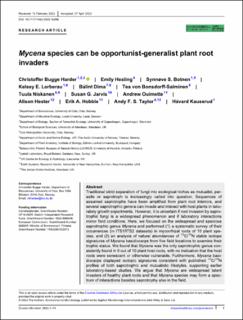| dc.contributor.author | Harder, Christoffer Bugge | |
| dc.contributor.author | Hesling, Emily | |
| dc.contributor.author | Botnen, Synnøve Smebye | |
| dc.contributor.author | Lorberau, Kelsey | |
| dc.contributor.author | Dima, Bálint | |
| dc.contributor.author | von Bonsdorff-Salminen, Tea | |
| dc.contributor.author | Niskanen, Tuula | |
| dc.contributor.author | Jarvis, Susan G. | |
| dc.contributor.author | Ouimette, Andrew | |
| dc.contributor.author | Hester, Alison | |
| dc.contributor.author | Hobbie, Erik A. | |
| dc.contributor.author | Taylor, Andy F. S. | |
| dc.contributor.author | Kauserud, Håvard | |
| dc.date.accessioned | 2023-07-04T09:19:56Z | |
| dc.date.available | 2023-07-04T09:19:56Z | |
| dc.date.created | 2023-06-05T18:13:29Z | |
| dc.date.issued | 2023 | |
| dc.identifier.citation | Environmental Microbiology. 2023, . | en_US |
| dc.identifier.issn | 1462-2912 | |
| dc.identifier.uri | https://hdl.handle.net/11250/3075504 | |
| dc.description.abstract | Traditional strict separation of fungi into ecological niches as mutualist, par- asite or saprotroph is increasingly called into question. Sequences of assumed saprotrophs have been amplified from plant root interiors, and several saprotrophic genera can invade and interact with host plants in labo- ratory growth experiments. However, it is uncertain if root invasion by sapro- trophic fungi is a widespread phenomenon and if laboratory interactions mirror field conditions. Here, we focused on the widespread and speciose saprotrophic genus Mycena and performed (1) a systematic survey of their occurrences (in ITS1/ITS2 datasets) in mycorrhizal roots of 10 plant spe- cies, and (2) an analysis of natural abundances of 13C/15N stable isotope signatures of Mycena basidiocarps from five field locations to examine their trophic status. We found that Mycena was the only saprotrophic genus con- sistently found in 9 out of 10 plant host roots, with no indication that the host roots were senescent or otherwise vulnerable. Furthermore, Mycena basi- diocarps displayed isotopic signatures consistent with published 13C/15N profiles of both saprotrophic and mutualistic lifestyles, supporting earlier laboratory-based studies. We argue that Mycena are widespread latent invaders of healthy plant roots and that Mycena species may form a spec- trum of interactions besides saprotrophy also in the field. | en_US |
| dc.language.iso | eng | en_US |
| dc.publisher | Wiley [Commercial Publisher] Applied Microbiology International [Society Publisher] | en_US |
| dc.rights | Navngivelse 4.0 Internasjonal | * |
| dc.rights.uri | http://creativecommons.org/licenses/by/4.0/deed.no | * |
| dc.title | Mycena species can be opportunist-generalist plant root invaders | en_US |
| dc.type | Journal article | en_US |
| dc.type | Peer reviewed | en_US |
| dc.description.version | publishedVersion | en_US |
| cristin.ispublished | true | |
| cristin.fulltext | original | |
| cristin.qualitycode | 2 | |
| dc.identifier.doi | 10.1111/1462-2920.16398 | |
| dc.identifier.cristin | 2152070 | |
| dc.source.journal | Environmental Microbiology | en_US |
| dc.source.pagenumber | 01-19 | en_US |

